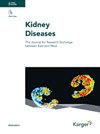Longitudinal Follow-Up and Outcomes for Chinese Patients with Stage 1–4 Chronic Kidney Disease
IF 3.2
4区 医学
Q1 UROLOGY & NEPHROLOGY
引用次数: 2
Abstract
Introduction: Understanding heterogeneity in the prognosis of chronic kidney disease (CKD) has implications in management of patients. We aimed to evaluate the comparative risk of end-stage kidney disease (ESKD), cardiovascular (CV) events, and death among patients with CKD in China. Methods: In total, 3,700 patients with CKD stage 1–4 were recruited from 39 clinical centers in China between 2011 and 2016. New occurrence of ESKD, CV events, and all-cause mortality was recorded until the end of 2017. The crude incidence rate was calculated for each outcome. Ratios of incidence between different outcomes were generated with 95% confidence interval (CI) estimated by 1,000 times of bootstrapping. Multivariable adjusted Cox regression models accounting for competing risk between the outcomes were used to evaluate the association of risk factors with the outcomes. Results: The population mean age was 50 ± 14 years, with 58.2% male and 60.3% of glomerulonephritis. After a median follow-up of 4.65 years (interquartile range [IQR]: 3.71–5.60 years) for ESKD, 4.76 years (IQR: 3.97–5.76 years) for CV events, and 4.84 years (IQR: 3.97–5.76 years) for death, the incidence rates of the 3 outcomes were 3.1, 1.5, and 0.92/100 patient-years, respectively. The ratio for the incidence of ESKD and CV events was 2.15 (95% CI: 1.87, 2.53) and that for incidence of ESKD and death was 3.41 (95% CI: 2.88, 4.08). Significant differences regarding the ratios were detected through levels of age, history of CV disease, the estimated glomerular filtration rate (eGFR), urine albumin-to-creatinine ratio (uACR), and etiology of CKD. In the Cox regression model adjusting for traditional CV and kidney-specific risk factors, older age was associated with a higher risk of CV events and death but a lower risk of ESKD (hazard ratios [HRs] = 1.45 [95% CI: 1.29, 1.64], 1.48 [95% CI: 1.29, 1.70], and 0.78 [95% CI: 0.73, 0.84] per 10 year increase, respectively). By comparison, reduced eGFR was associated with a higher risk of ESKD and death, rather than CV events (HRs = 3.62 [95% CI: 2.96, 4.43], 1.30 [95% CI: 1.02, 1.66], and 1.22 [95% CI: 0.99, 1.49] per 30.26 mL/min/1.73 m2 increase, respectively). Similar patterns were seen for increased uACR (HRs = 1.42 [95% CI: 1.30, 1.55], 1.17 [95% CI: 1.05, 1.30], and 1.07 [95% CI: 0.99, 1.17] per 1 natural log-transformed value increase, respectively). Conclusion: ESKD was more likely to occur than CV events and death in the population with CKD stage 1–4 in China. Traditional risk factors contributed differently to the comparative risk of the outcomes.中国1-4期慢性肾病患者的纵向随访和结局
了解慢性肾脏疾病(CKD)预后的异质性对患者的管理具有重要意义。我们的目的是评估中国CKD患者终末期肾脏疾病(ESKD)、心血管(CV)事件和死亡的比较风险。方法:2011年至2016年,从中国39个临床中心招募了3700名1-4期CKD患者。截至2017年底,记录了ESKD、CV事件和全因死亡率的新发病例。计算每个结局的粗发生率。不同结果之间的发生率比率以95%置信区间(CI)生成,该置信区间由1000次bootstrapping估计。采用考虑结果之间竞争风险的多变量调整Cox回归模型来评估风险因素与结果的相关性。结果:人群平均年龄50±14岁,男性占58.2%,肾小球肾炎占60.3%。ESKD的中位随访时间为4.65年(四分位间距[IQR]: 3.71-5.60年),CV事件的中位随访时间为4.76年(IQR: 3.97-5.76年),死亡的中位随访时间为4.84年(IQR: 3.97-5.76年),3种结局的发病率分别为3.1、1.5和0.92/100患者年。ESKD与CV事件的发生率之比为2.15 (95% CI: 1.87, 2.53), ESKD与死亡的发生率之比为3.41 (95% CI: 2.88, 4.08)。通过年龄、心血管疾病史、肾小球滤过率(eGFR)、尿白蛋白与肌酐比(uACR)和CKD病因的水平,检测到这些比率的显著差异。在校正传统CV和肾脏特异性危险因素的Cox回归模型中,年龄越大,CV事件和死亡的风险越高,但ESKD的风险越低(每10年风险比分别为1.45 [95% CI: 1.29, 1.64]、1.48 [95% CI: 1.29, 1.70]和0.78 [95% CI: 0.73, 0.84])。相比之下,eGFR降低与ESKD和死亡的高风险相关,而不是与CV事件相关(hr分别为3.62 [95% CI: 2.96, 4.43], 1.30 [95% CI: 1.02, 1.66]和1.22 [95% CI: 0.99, 1.49],每增加30.26 mL/min/1.73 m2)。uACR的增加也出现了类似的模式(hr = 1.42 [95% CI: 1.30, 1.55], 1.17 [95% CI: 1.05, 1.30]和1.07 [95% CI: 0.99, 1.17]每增加1个自然对数转换值)。结论:在中国CKD 1-4期人群中,ESKD比CV事件和死亡更容易发生。传统的风险因素对结果的比较风险有不同的贡献。
本文章由计算机程序翻译,如有差异,请以英文原文为准。
求助全文
约1分钟内获得全文
求助全文
来源期刊

Kidney Diseases
UROLOGY & NEPHROLOGY-
CiteScore
6.00
自引率
2.70%
发文量
33
审稿时长
27 weeks
期刊介绍:
''Kidney Diseases'' aims to provide a platform for Asian and Western research to further and support communication and exchange of knowledge. Review articles cover the most recent clinical and basic science relevant to the entire field of nephrological disorders, including glomerular diseases, acute and chronic kidney injury, tubulo-interstitial disease, hypertension and metabolism-related disorders, end-stage renal disease, and genetic kidney disease. Special articles are prepared by two authors, one from East and one from West, which compare genetics, epidemiology, diagnosis methods, and treatment options of a disease.
 求助内容:
求助内容: 应助结果提醒方式:
应助结果提醒方式:


